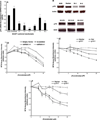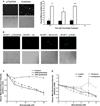p75NTR: an enhancer of fenretinide toxicity in neuroblastoma
- PMID: 23314735
- PMCID: PMC3581726
- DOI: 10.1007/s00280-013-2071-7
p75NTR: an enhancer of fenretinide toxicity in neuroblastoma
Abstract
Objective: Neuroblastoma is a common, frequently fatal, neural crest tumor of childhood. Chemotherapy-resistant neuroblastoma cells typically have Schwann cell-like ("S-type") morphology and express the p75 neurotrophin receptor (p75NTR). p75NTR has been previously shown to modulate the redox state of neural crest tumor cells. We, therefore, hypothesized that p75NTR expression level would influence the effects of the redox-active chemotherapeutic drug fenretinide on neuroblastoma cells.
Methods: Transfection and lentiviral transduction were used to manipulate p75NTR expression in these cell lines. Sensitivity to fenretinide was determined by concentration- and time-cell survival studies. Apoptosis incidence was determined by morphological assessment and examination of cleavage of poly-ADP ribose polymerase and caspase-3. Generation and subcellular localization of reactive oxygen species were quantified using species- and site-specific stains and by examining the effects of site-selective antioxidants on cell survival after fenretinide treatment. Studies of mitochondrial electron transport employed specific inhibitors of individual proteins in the electron transport chain.
Results: Knockdown of p75NTR attenuates fenretinide-induced accumulation of mitochondrial superoxide and apoptosis. Overexpression of p75NTR has the opposite effects. Pretreatment of cells with 2-thenoyltrifluoroacetone or dehydroascorbic acid uniquely prevents mitochondrial superoxide accumulation and cell death after fenretinide treatment, indicating that mitochondrial complex II is the likely site of fenretinide-induced superoxide generation and p75NTR-induced potentiation of these phenomena.
Conclusion: Modification of expression of p75NTR in a particular neuroblastoma cell line modifies its susceptibility to fenretinide. Enhancers of p75NTR expression or signaling could be potential drugs for use as adjuncts to chemotherapy of neural tumors.
Conflict of interest statement
None of the authors have any real or perceivable conflicts of interest or financial relationships relevant to the contents of this manuscript.
Figures





Similar articles
-
p75 neurotrophin receptor and fenretinide-induced signaling in neuroblastoma.Cancer Chemother Pharmacol. 2014 Feb;73(2):271-9. doi: 10.1007/s00280-013-2355-y. Epub 2013 Nov 20. Cancer Chemother Pharmacol. 2014. PMID: 24253178 Free PMC article.
-
Cell Line-Dependent Variability of Coordinate Expression of p75NTR and CRABP1 and Modulation of Effects of Fenretinide on Neuroblastoma Cells.Oxid Med Cell Longev. 2016;2016:7568287. doi: 10.1155/2016/7568287. Epub 2015 Dec 30. Oxid Med Cell Longev. 2016. PMID: 26843908 Free PMC article.
-
Fenretinide induces mitochondrial ROS and inhibits the mitochondrial respiratory chain in neuroblastoma.Cell Mol Life Sci. 2010 Mar;67(5):807-16. doi: 10.1007/s00018-009-0212-2. Epub 2009 Nov 26. Cell Mol Life Sci. 2010. PMID: 19941060 Free PMC article.
-
Molecular mechanisms of fenretinide-induced apoptosis of neuroblastoma cells.Ann N Y Acad Sci. 2004 Dec;1028:81-9. doi: 10.1196/annals.1322.009. Ann N Y Acad Sci. 2004. PMID: 15650234 Review.
-
Induction of GADD153 and Bak: novel molecular targets of fenretinide-induced apoptosis of neuroblastoma.Cancer Lett. 2003 Jul 18;197(1-2):157-63. doi: 10.1016/s0304-3835(03)00098-3. Cancer Lett. 2003. PMID: 12880976 Review.
Cited by
-
Induction of Expression of p75 Neurotrophin Receptor Intracellular Domain Does Not Induce Expression or Enhance Activity of Mitochondrial Complex II.Oxid Med Cell Longev. 2016;2016:8752821. doi: 10.1155/2016/8752821. Epub 2015 Nov 10. Oxid Med Cell Longev. 2016. PMID: 26640617 Free PMC article.
-
Neurotrophin Signaling in Medulloblastoma.Cancers (Basel). 2020 Sep 7;12(9):2542. doi: 10.3390/cancers12092542. Cancers (Basel). 2020. PMID: 32906676 Free PMC article. Review.
-
Upregulation of p75NTR by Histone Deacetylase Inhibitors Sensitizes Human Neuroblastoma Cells to Targeted Immunotoxin-Induced Apoptosis.Int J Mol Sci. 2022 Mar 31;23(7):3849. doi: 10.3390/ijms23073849. Int J Mol Sci. 2022. PMID: 35409209 Free PMC article.
-
p75 neurotrophin receptor and fenretinide-induced signaling in neuroblastoma.Cancer Chemother Pharmacol. 2014 Feb;73(2):271-9. doi: 10.1007/s00280-013-2355-y. Epub 2013 Nov 20. Cancer Chemother Pharmacol. 2014. PMID: 24253178 Free PMC article.
-
Sciatic nerve regeneration using a nerve growth factor-containing fibrin glue membrane.Neural Regen Res. 2013 Dec 25;8(36):3416-22. doi: 10.3969/j.issn.1673-5374.2013.36.007. Neural Regen Res. 2013. PMID: 25206664 Free PMC article.
References
-
- Bartkowska K, Turlejski K, Djavadian RL. Neurotrophins and their receptors in early development of the mammalian nervous system. Acta Neurobiol Exp. 2010;70:454–467. - PubMed
-
- Yan C, Liang Y, Nylander KD, et al. p75-NGF as an antiapoptotic complex: independence vs. cooperativity. Mol Pharmacol. 2002;61:710–719. - PubMed
-
- Buhren J, Christoph AHA, Buslei R, et al. Expression of the neurotrophin receptor p75NTR in medulloblastomas is correlated with distinct histological and clinical features: evidence for a medulloblastoma subtype derived from the external granule cell layer. J Neuropathol Exp Neurol. 2000;59:229–240. - PubMed
Publication types
MeSH terms
Substances
Grants and funding
LinkOut - more resources
Full Text Sources
Other Literature Sources
Medical
Research Materials

